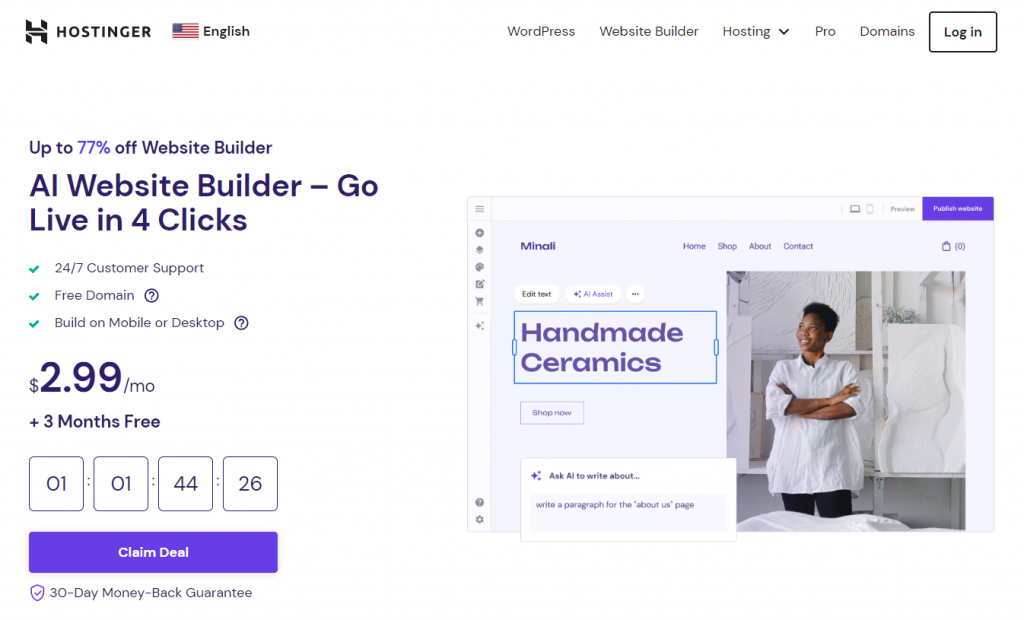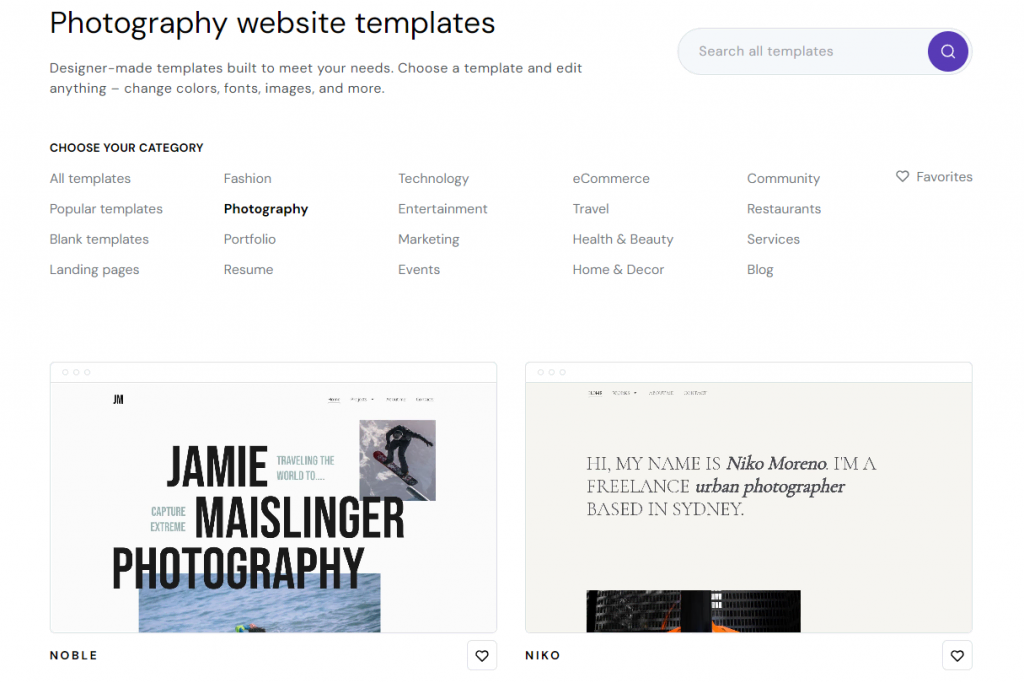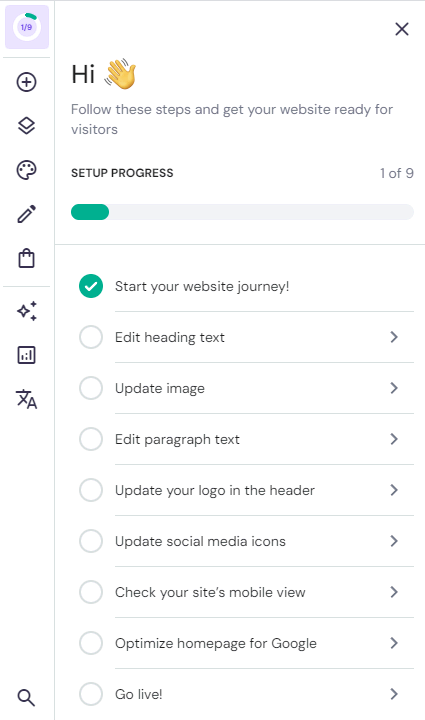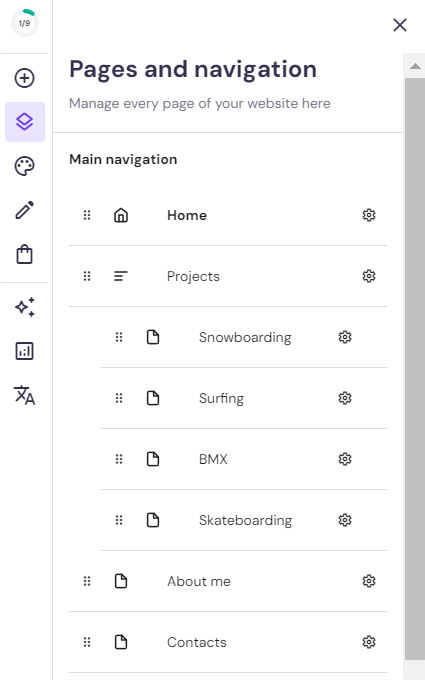How to Make a Photography Portfolio Website that Stands Out in 2024
Creating a captivating photography portfolio has become essential for photographers to showcase their skills and connect with future clients. A photography portfolio acts as a visual identity, professional calling card, and storytelling canvas all in one.
Whether you’re an aspiring photographer looking to kickstart your career or an experienced professional aiming to take your business to new heights, the power of a well-crafted photo portfolio site cannot be underestimated.
This article will share the steps and tips to guide you in creating a professional photography portfolio. With such information at your disposal, you’ll be on the right path to building a successful photography business.

How to Make a Photography Portfolio
Follow these six steps to craft a standout photography portfolio that will help you attract potential clients.
1. Set Clear Objectives
Before diving into the creative process, it’s crucial to set clear goals for your online portfolio. Define specific objectives, such as to attract clients, gain exposure, or share your work with a particular audience.
Think about who you are hoping to reach and the key elements that you need to highlight to make an impact. For this, craft an audience persona covering:
- Demographics. Consider the age, location, and occupation of your ideal audience. Understanding these basic demographics helps you decide on the tone and content of your photography portfolio.
- Interests and hobbies. Delve into your potential viewers’ interests, hobbies, and passions. Think about whether they are photography enthusiasts, art collectors, or potential clients seeking professional photography services.
- Needs and pain points. Identify what problems your photography portfolio can solve and how your work can fulfill the target audience’s aspirations.
- Online behavior. To understand your audience better, research their online activity. Tailor your marketing by identifying whether they are active on photography forums or community websites. Use this information to better connect with them.
- Aesthetics. Consider your target audience’s visual preferences, including styles, colors, and design elements. Understanding their aesthetic preferences will help you tailor your work presentation.
This preliminary strategizing supports you in creating a photography portfolio tailored to your target market. By building a detailed audience persona, you’ll gain invaluable insights into the characteristics and preferences of your intended viewers.
Once you have identified your goals and understood your target audience, it’s time to start planning the entire website structure.
Outline your photography portfolio organization in terms of menus and pages to help visitors navigate through your website. Consider how many pages you need and what content should appear on each portfolio page.
2. Choose Your Finest Work
One of the best practices for portfolio presentation is to curate it with your best photos. This is because your portfolio should reflect your skills and style as a photographer.
Take the time to critically evaluate your work and select images that showcase your unique vision and talent. Here are some tips for photography portfolio curation:
- Highlight your best shots. Be strategic in your selection process – only include the best images representing your skills and artistic vision.
- Quality over quantity. It’s tempting to showcase a large number of images, but quality should always be your top priority. Choose photos that are technically outstanding with sharp focus, proper exposure, and good composition.
- Audience perspective. Put yourself in the perspective of the target audience and tailor your selections to cater to their preferences and expectations.
- Remove redundancy. Avoid redundancy by omitting similar shots. If you have several images of the same subject with minor variations, choose the strongest one to represent that series.
While visually stunning, high-resolution photos can slow down your website’s loading speed. This may cause a poor user experience and potentially drive visitors away.
Image optimization is the solution to strike a balance between quality and loading speed. Use a lossless image compression tool to help reduce file sizes without sacrificing quality. This strategy helps maintain fast loading times while preserving the visual appeal of your work.
Additionally, if your portfolio includes a substantial number of images, use a content delivery network to distribute content efficiently and reduce latency for visitors worldwide.
3. Make a Digital Photography Portfolio Site
The next step is to create a photography website. Your online photography portfolio will serve as the virtual gateway for your target audience and potential clients to evaluate your skills. It’s an indispensable component of your professional identity.
Hostinger’s website maker is the perfect solution for this. It has an intuitive interface, designer-made templates, and extensive customization tools. If this is your first time building a photography portfolio, you won’t have to worry about the technicalities.
Here are the steps to build a photography site using our AI-powered portfolio builder:
- Select a Hostinger Website Builder plan and sign up for a Hostinger account.
- Pick a photography portfolio layout and template that suits your style.
- Personalize the website with your branding, colors, and fonts. You can follow the SETUP PROGRESS checklist on the builder’s left sidebar.
- Create galleries to group your photography projects, such as landscapes, portraits, or events. Click on Pages and navigation to adjust the pages based on your needs.
- Upload your images and use the drag-and-drop feature to arrange them in a visually pleasing layout, ensuring easy navigation for viewers.
Pro Tip
Well-optimized media files can boost your site’s search engine ranking. Ensure your photos have relevant file names, alt tags, and descriptions.
- Create the other online photography portfolio essentials, such as the About and Contact pages.
- Once you’re happy with your photography portfolio website’s look and feel, publish the site.
Ensure to check out our AI-powered logo, copy, and heatmap tools to further accelerate your website development process.
We also offer built-in mobile optimization and SEO solutions. Aside from the improved user experience, these tools help enhance your portfolio’s discoverability. That way, your photo portfolio will look seamless on various devices and rank well on search engine results pages (SERPs).
Once everything is set up, you can start regularly updating and promoting your photography portfolio to attract quality leads and grow your client base.
Suggested Reading
To enhance your online presence, especially if you’re keen on showcasing photography or delving into web design, consider exploring these resources:
The Best Website Builder for Photographers
20 Best Photography Website Examples
How to Design a Website
20 Best Website Design Examples
Web Design Best Practices to Attract More Website Visitors
4. Make High-Quality Prints
While a website is essential, don’t overlook the significance of a high-quality printed photography portfolio. It’s an invaluable asset for when you’re meeting clients in person.
Many clients and art enthusiasts appreciate tangible representations of your work. To make your photo portfolio shine, optimize your images for printing to ensure their quality. Also, carefully select a print shop that can customize the materials to meet your needs.
Providing both digital and physical portfolios offers a comprehensive experience where your target audience can appreciate your photos’ finer details and craftsmanship via their preferred method.
Suggested Reading
Check out our article on how to sell photos online to gain insights about the best websites for selling images and some profit maximization tips.
5. Add Context and Storytelling
Photographs should involve more than just images. Effective storytelling in photography portfolios transforms the work into a narrative that captures audiences’ interest. Each image can serve as a chapter in a captivating story.
Therefore, incorporating storytelling as you build a photography website invites viewers to a journey through your creative lens.
The strategic use of context and storytelling is the key to crafting an impressive photographer’s portfolio. These aspects help engage a potential client more emotionally and establish a lasting impression.
To elevate your photography portfolio website, add captions or concise descriptions for each image. These annotations provide context to your work, offering viewers a deeper understanding.
6. Regularly Update Your Portfolio
A professional photography portfolio should act as a dynamic representation of your growth and progress as a photographer.
To ensure it reflects your current work and capabilities, commit to regularly updating your photography portfolio. By consistently adding your latest work, you keep the portfolio fresh and aligned with your artistic development.
Maintaining a vibrant portfolio isn’t just about additions – it involves curatorial decisions. Consider periodically reviewing your older pieces and assessing whether they still align with your current artistic style and vision.
As your photography evolves, you may find that certain older projects no longer resonate with your creative direction. In such cases, don’t hesitate to remove these pieces from your photo portfolio.
This thoughtful curation ensures that your professional photographer portfolio maintains its relevance. It also helps the prospective client perceive a cohesive body of work that accurately represents your artistic identity.
Photography Portfolio Tips
Creating an impactful photography portfolio goes beyond just showcasing images. Let’s go over some tips to elevate your portfolio and build a successful photography business.
Find Inspiration
One of the most important steps in creating a photography website is finding inspiring photography portfolio examples.
Browse renowned portfolio sites by photographers in your niche. Take note of the layout, style, and content. From there, identify what makes these photography websites resonate with audiences. Is it the color scheme, the types of shots, or perhaps the storytelling?
It’s also a good idea to join photography forums and follow photography blogs to find inspiration for your own photography portfolio. That way, you can stay updated with trends and new techniques that you can incorporate.
Another great tip is to use social media to find photography portfolio design inspiration. Platforms like Instagram and Pinterest are full of creative photography portfolios. Use them as a visual brainstorming tool when building a photography website of your own.
Keep in mind that the goal isn’t to copy others’ work but to spark your own creativity. Let these portfolios serve as inspiration to gain a clearer vision of what you want your portfolio to be. This will make the building process much more straightforward and the end result more compelling.
Get Feedback
When building a photography portfolio, seeking feedback is a pivotal step in refining your photography portfolio website. This process elevates your digital resume and cultivates your photography career growth.
Understanding the significance of feedback is the first step. Peers and mentors can offer fresh perspectives and insights you might have missed.
Objective feedback from a trusted photographer or photo editor in the community helps you identify strengths and weaknesses in your selection.
You can also show your photography portfolio website to a few individuals representing your target audience. Their feedback can reveal how well your work resonates with the intended viewers.
Learning how to receive constructive feedback and turn it into something actionable is important. Such feedback can guide you and be the catalyst for remarkable progress. Here are some tips to consider:
- Stay open-minded. Approach feedback with an open mind. Remember that it’s about your work, not your worth as a photographer.
- Don’t take it personally. Detach yourself emotionally from the feedback. Understand that it aims to enhance your portfolio, not diminish your abilities.
- Ask for specifics. Encourage those providing feedback to be specific about what works and what can be improved. Feedback should be actionable and help you focus on precise areas.
- Respond respectfully. Express gratitude for the feedback, even if it’s not entirely positive. Acknowledge the effort taken to help you improve.
- Reflect and act. Take the time to reflect on the feedback. Assess whether it aligns with your artistic vision and goals. If it does, take concrete steps to incorporate the suggested changes.
Keep in mind that feedback isn’t a one-time endeavor but an ongoing process. Regularly seeking input and making gradual improvements will refine your online portfolio over time.
Highlight Diversity
Diversity is a magnet for a broader audience. It acknowledges that photography is a multifaceted art catering to various tastes and preferences.
Someone interested in landscape shots might also appreciate architectural photography. As a result, incorporating diversity may lead to more opportunities and commissions.
While specializing in a particular niche can establish your expertise, it’s equally important to demonstrate versatility within that niche. This versatility sets you apart from others in the same field. It shows potential clients that you aren’t confined to a single style or approach but can offer various perspectives and solutions.
To achieve versatility, explore different styles, techniques, and approaches within your chosen specialization. Experiment with various lighting conditions, compositions, and post-processing methods.
This experimentation keeps your work fresh and appeals to clients seeking professional photographers who can bring unique and innovative perspectives to their projects.
Incorporating diversity in your photography portfolio broadens your appeal and positions you as an adaptable photographer.
It invites viewers and potential clients to explore the richness of your work and envision how your skills can enhance their projects. Ultimately, this helps improve your competitive edge in the photography industry.
Further Reading
For those ready to dive into website creation, from personal portfolios to comprehensive sites, we recommend:
How to Make a Website From Scratch
How to Make a Portfolio
Conclusion
Creating a captivating photography portfolio is crucial for photographers in 2024.
In this guide to craft a photography portfolio for beginners, we’ve explored how to make a unique website to showcase your work. Here’s a short recap:
- Set clear objectives and create an audience persona.
- Curate your best photos.
- Build an online photography portfolio.
- Consider creating printed portfolios.
- Add context and incorporate storytelling into your work.
- Update your online portfolios regularly.
Remember that your portfolio is a dynamic representation of your growth and progress.
Ensure to seek feedback from peers, mentors, and your target audience to refine your work and engage clients. Also, embrace diversity in your portfolio to appeal to a broader audience and showcase your versatility as a photographer.
Good luck creating your own photography website!
How to Make a Photography Portfolio FAQ
Creating a compelling photography portfolio is essential for showcasing your work. Here are some common questions about how to make a photography portfolio – answered.
What Is a Photography Portfolio?
A photography portfolio contains a curated collection of your best photos. It also serves as a digital resume, demonstrating your skills, artistic style, and expertise to potential clients or employers.
What Makes a Good Photography Portfolio?
A good photography portfolio should include high-quality images representing your unique style and skills. It should have a clear and consistent style and theme, a well-organized layout, and photos that tell a compelling story.
How Many Photos Should Be in a Photography Portfolio?
The number of photos in a photography portfolio can vary. Having around 15 to 20 of your best and most diverse images is generally recommended. Quality should always take precedence over quantity.








